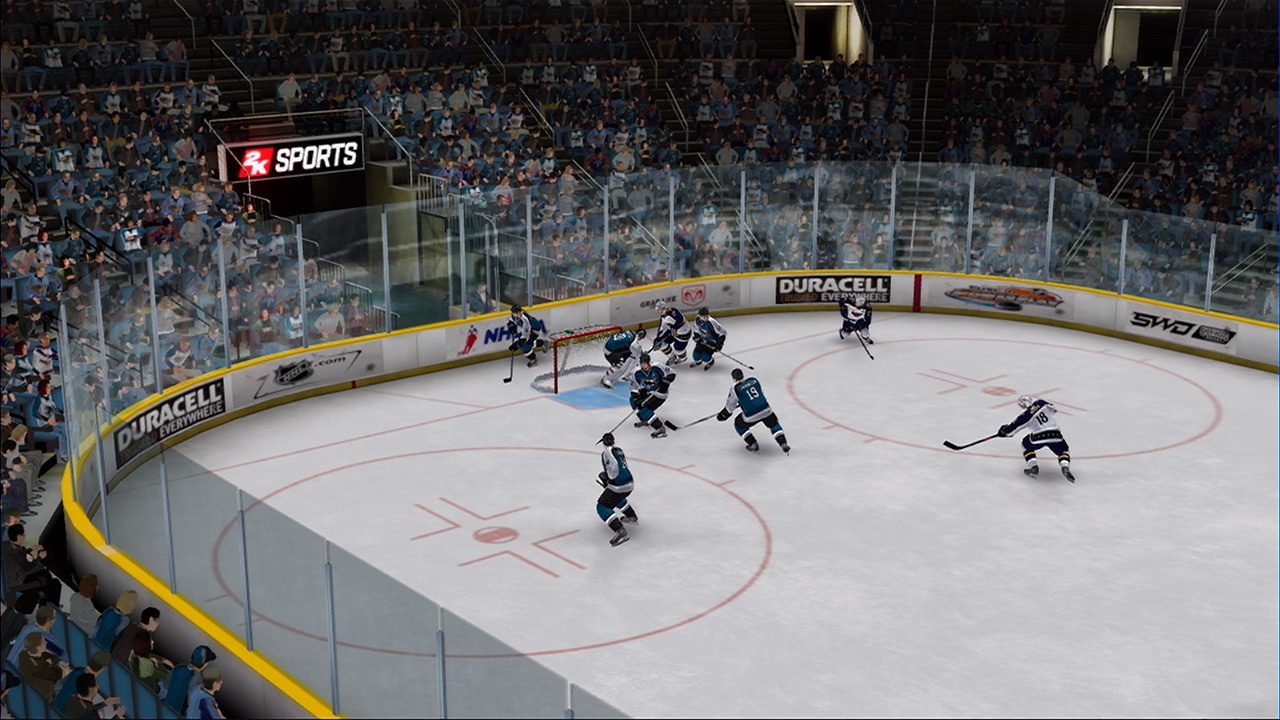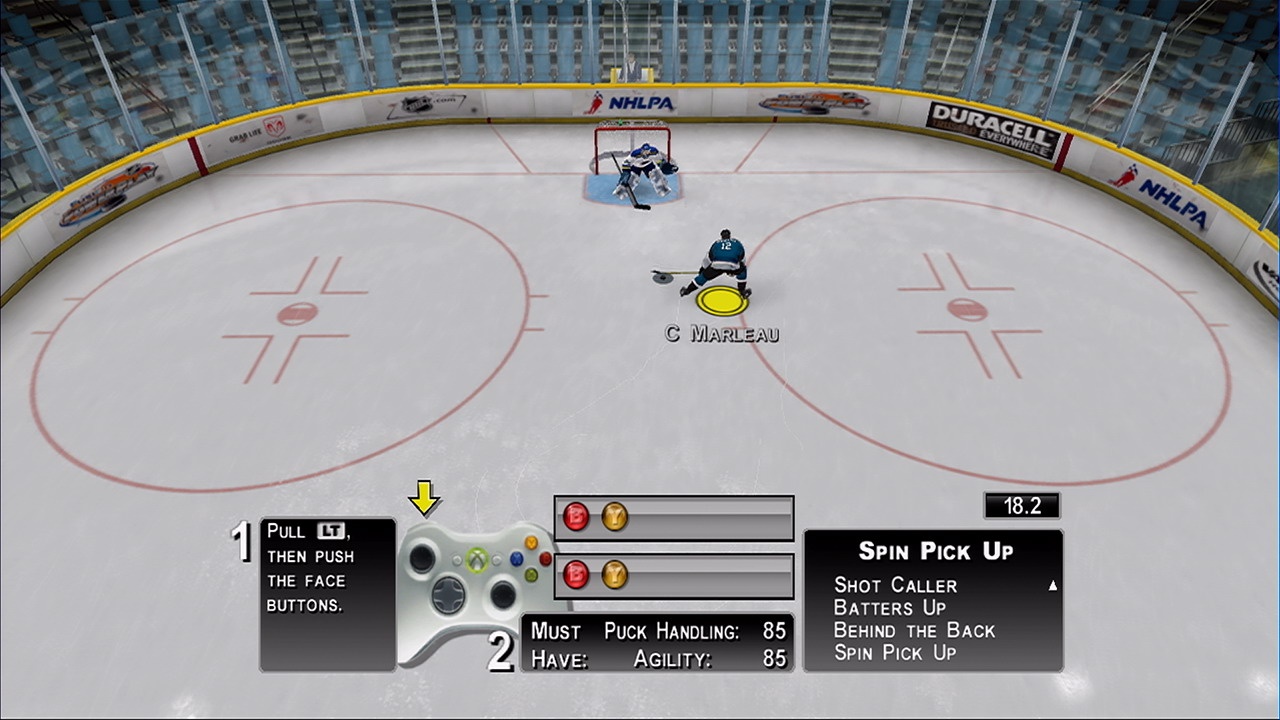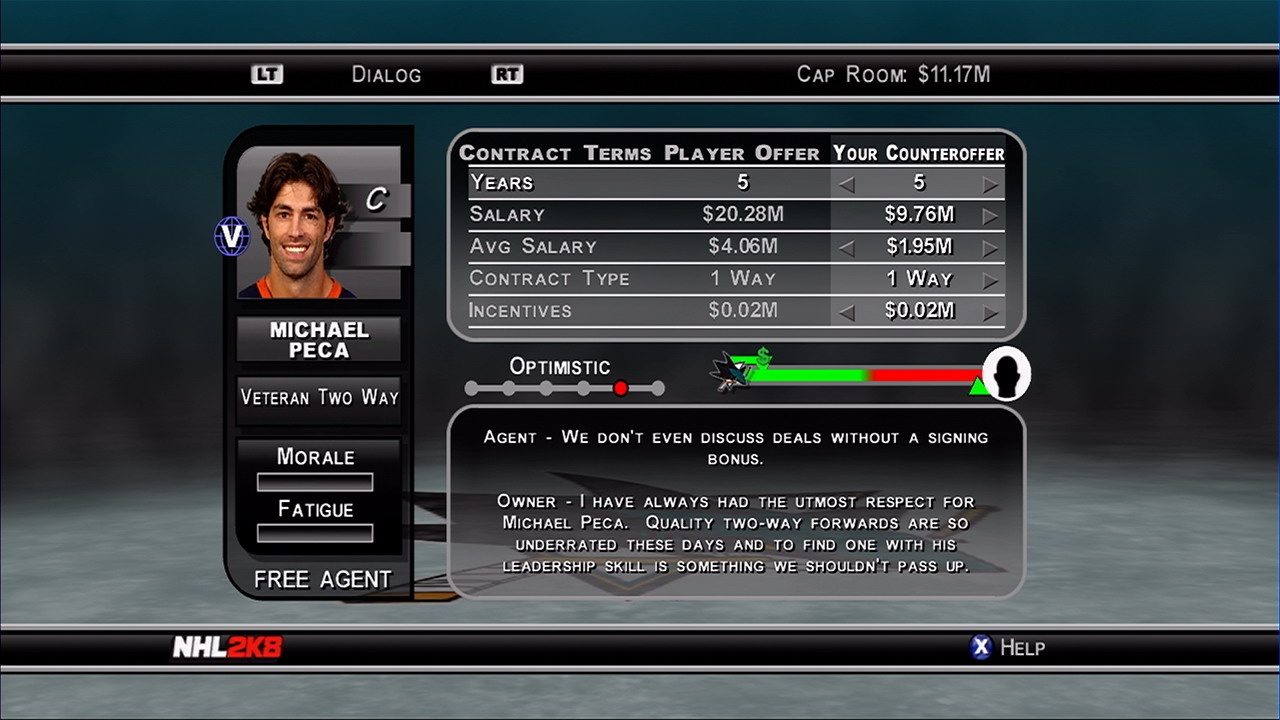For years now, 2K Sports' NHL 2K series has been the gold standard for hockey games, both in gameplay and depth of content. But over the last couple of installments, a trend has been developing. While certain strides have been made to improve various aspects of the game in each installment, these changes have become less and less significant. Last year, most of the work went into the presentation, which left the fun yet aging gameplay engine much the same as it was in NHL 2K6. In NHL 2K8, the gameplay has been reworked in some key areas, but many of these changes don't really improve the gameplay so much as change it for the sake of changing it. There isn't the feeling that 2K8 has really moved the series forward in any major capacity, and in some regards, it feels like a step backward. This is a good game of hockey that's jam-packed with features, but it's nowhere near the level of quality the series has previously set for itself.

Most people's first reaction to NHL 2K8 will probably be, "Wait, what the heck happened to the controls?" That's because the controls in 2K8 have been completely reworked, and not necessarily for the better. For example, shooting and passing have been mapped to the bumpers on the Xbox 360 controller, and to the R1 and L1 buttons on the PlayStation 3 controller. On top of that, the L2/left trigger buttons now act as a modifier for slap shots by default, so if you want to do one, you have to hold it down and press the shoot button. While this does make things a bit more involved than the age-old methodology of hammering on a shoot button until the puck goes in, it also makes the early hours of the game kind of a pain as you try to figure out how to effectively shoot the puck. You will get used to it, but even once you do, it never feels quite right.
The other big change to the game is the "pro-stick," otherwise known as 2K's attempt to rework the right analog stick into something more than just a way to pull off a preset deke. Essentially, you can now use the right analog stick to move the puck from side to side on offense, and to swipe and poke check on defense. Unfortunately, it isn't actually that useful in most situations. On the defensive side, the poke check feels very hit-or-miss, and it actually felt better last year when the poke check was just a button press. On offense, you get a decent range of motion when moving with the stick, but the responsiveness just isn't there. The stick isn't dynamic enough to really let you move the puck quickly, and for the most part it simply feels stiff. Given that EA pretty much set the hockey world on fire with its skill stick mechanic, it's understandable that 2K would want to come back with its own right-analog-stick innovation. It's too bad that this one feels more like a half-cocked knockoff than anything else. If you're going to try to match someone else's gameplay innovation, go all the way with it. Don't deliver something that's only half as useful.
The control goofiness doesn't end there. There are now two speed bursts in the game, one of which is the standard, sustained speed burst, and the other is a real quick burst that's supposed to push you past defenders for a breakaway. They don't really feel much different from one another, save for the fact that one ends sooner; you just end up feeling that the second speed-burst button could have been used for something more useful, like, say, icon passing. For some dopey reason, icon passing has now been mapped to the select button on the PS3, and the back button on the 360. Given that you can use this feature only when you're in the offensive zone and have control of the puck, you have a very narrow window of time to turn on icon passing and set up a play. Fumbling for the least accessible button on both controllers to engage icon passing is the opposite of fun, and often leads you to lose the puck when you get checked out of your skates.
Which brings up another issue with NHL 2K8: checking. Checking is always fun, especially when you knock a guy flat on his back, but the amount that you can check and the frequency of big hits in 2K8 is just crazy. Every check seems to knock a guy off his skates, regardless of size or strength. On harder difficulty settings, it seems as if the artificial intelligence is a bit better about avoiding your checks, but you can still lay out opponents in ridiculous fashion. Never, ever in a million, billion years should the 5'9", 165 pound Steve Sullivan be able to lay out the 6'9", 260 pound Zdeno Chara on the ice, short of putting rockets on his skates and holding his stick out like a lance in a jousting contest. But lo and behold, you can do it here. This is supposed to be a realistic simulation of hockey, but at times, 2K8 feels as if it has more in common with Midway's NHL Hitz series than the real-life sport.
Granted, that's a lot of negative talk for something that is, by and large, a good hockey game. For what it's worth, there is good to be found here, though a great deal of it is due to holdover mechanics from previous games. 2K8's method of goalie control is still the most enjoyable interpretation of the position to be found in any game, and the game still uses the best default camera angle in the business. Apart from the stiffness of the right-analog-stick controls, the rest of the controls are quite responsive. Moving up and down the ice feels great. You also have the option of switching to one of the older control schemes from previous years, though that essentially makes you feel like you're playing last year's game, instead of a new iteration.

There are also a couple of new things in this year's game that definitely benefit the overall experience. First are the superstar moves, which are a roster of maneuvers that only top-flight forwards are capable of pulling out. By holding down the left trigger/L2 button and pressing a combination of two of the controller's face buttons, your forward will go into some kind of ridiculous animation before shooting the puck in ridiculous fashion. Whether it's faking a whiff, spinning like a top, or pulling a Marek Malik-style through-the-legs shot, these moves are awesome. The only bummer about them is that their usefulness is so limited. They're absolutely great during shootouts because they let you get real fancy against opposing goalies. But in traffic, you're more likely to get slammed to the ice than you are to pull off a 360-degree spin before shooting the puck. There are also so many moves that it can be difficult to memorize all the different ones, meaning you might occasionally pull out the wrong moves at the wrong times.
Another useful change is faceoffs. You use the right analog stick to set where you want your stick to be prior to a faceoff, and release it the second the puck is dropped. If you and your opponent end up hitting at the same time, it will result in a tie-up, and another player will have to skate in and grab the puck. If you time it just right, you'll knock the puck back to one of your teammates. It's a neat system that feels much more like real faceoffs, though you do seem to end up in a few more tie-ups than is realistic.
Lastly, and perhaps most beneficial to the game overall, is scoring. Yes, the shooting controls are a bit of a pain, but by some miracle, the actual scoring in 2K8 feels much, much better than it has in previous years. This is specifically because the one-timer no longer feels like the only way to score. You can actually hit big slap shots from the point and get them redirected by your teammates into the net, or pull off quick wristers on the breakaway and actually have them go in with proper consistency. It's a shame that most people might not even really notice this, given the weird control scheme and silly amount of checking, but it is a big improvement.
2K hockey has always been about incredible depth when it comes to gameplay modes, and 2K8 isn't a disappointment in this regard. Once again, the developer has delivered the deepest and most involved franchise mode of any sports game on the market. The biggest change is to contract negotiations, which have been totally overhauled into something more reminiscent of actual negotiations. Whenever you want to re-sign a player, pick up a free agent, or sign a member of your draft class, you're going to find yourself initially quite far apart in terms of money. A meter dictates where your owner wants the contract to be versus where the player's agent wants to be. Your goal is to try to get a player for as cheaply as possible while still giving some leeway to what the player wants. It's a tug-of-war that actually feels really authentic, right down to how you or the player can just up and walk away from the negotiating table when either side feels things aren't going right. Knowing when to walk away is, in itself, a skill to be learned, considering that at times players will simply cave and ultimately agree to your terms when you opt to walk away.

It goes even deeper than that. The collective-bargaining agreement between the league and the NHLPA has been implemented here with such detail that casual players are likely to roll their eyes back in their heads and pass out from trying to absorb all this information. For the most part, the game does a good job of explaining what each feature does, though some are left a bit opaque. For example, restricted free agents are kind of left on the fringe. The game never really makes clear what happens when you propose qualifying offers that players don't sign, so you may be initially confused as to why you have these guys you didn't sign still sitting around on your roster. It's just a very complex system that requires some research and occasional bouts of fumbling around with to finally grasp.
Most every other feature from previous years is on hand as well, including all the various management and coaching duties (assigning practices, balancing line chemistry, and the like). Rookie scouting seems to have disappeared altogether, though it's been replaced with more generally accurate and intuitive info about all the rookies in the draft class right from the get-go. There's also a whole new player-development system in this year's game, though quite frankly it doesn't make a ton of sense. After every game, players earn experience points that seemingly are there to build them up and improve their stats. The problem is that you never really get a good sense of how the game does that. You get these reports that show where players are in their development, but the whole thing just looks like a big jumble of arrows and names. The 2K hockey games have always had issues with menu and interface design, and this whole system seems like a big victim of that specific issue.
Of course, this wouldn't be a 2K hockey game if the franchise mode didn't come encumbered with a few bugs and quirks. One of the weirder features from previous years was the whole "opportunity knocks" system, a feature in which the team owner can essentially call you, and as a result something either good or bad can happen to your team. In this year's game, the amount of bad that comes from this feature is so lopsided that it pretty much makes ignoring it a better option. On top of that, sometimes it will actually cause bugs within the game. We had one situation where, while playing as the Devils, we took an "opportunity knocks" call right at the end of the season and before the playoffs. It was a bad one, and essentially sent Dainius Zubrus away from the team for seven days due to a "death in the family." The trouble is that he wasn't gone for only seven days. He was gone for the entire length of the playoffs. It's as if the game treats the playoffs as a single week, and as a result, that player was lost for the duration.
There's also some weirdness with the waiver wire. The game includes a realistic waiver system in which players with one-way contracts that are sent down to the minor leagues get put on waivers first, and any other team can claim that player. You periodically get notifications in your e-mail box about players that are put on waivers, but the game never actually tells you how you're supposed to put in a waiver claim for that player. Other teams can snake your players (and often do) when you send them down, but the game isn't up front about how you can take advantage of this same procedure. There's also a bit of insanity when it comes to which players are put on waivers. Half the notifications we got were for players rated 85 and up. You know something's busted when Jason Spezza, 2K8's cover athlete, is getting put on waivers in the middle of the season.
Apart from franchise, the usual modes are on hand as well, such as season mode, tournaments, pond hockey, minirink, and minigames. Most of these modes haven't been touched in any meaningful capacity. In fact, the minigames haven't been touched at all, to the extent that they still use last year's control scheme. Online play is also largely the same. Tournaments and seasons are available to play in the league option, and they're functionally identical to last year's game. The online games we played were basically lag-free, though all online games evidently run at about half the frame rate of the offline game, so you'll notice some significant and irritating choppiness when you hop into the online arena. We also ran into some connection issues with the PS3 version of the game.
NHL 2K8's graphics are a notable improvement over last year's game. Obviously, one of the bigger improvements is animation, specifically those awesome-looking superstar moves. But there are other animation upgrades spread throughout the game that are more subtle, yet more realistic-looking. Goalie animations in particular look a boatload better this year, and you'll actually see goalies come out to challenge for the puck, and drop into some pretty elaborate stances. The ice deforms better than any prior year, and player models have gotten a nice boost in detail, especially in the jerseys and equipment. Player faces still look a little bit funky in spots, but they aren't awful-looking by any means. Incidentally, the cinemotion feature from last year is still on hand this year, though it's turned off by default, and hasn't really seen any significant changes--which is odd, considering how highly touted a feature it was in last year's game.

Audio is pretty much on par with last year's entry. Commentators Bob Cole and Harry Neale seem to have a bit more to say this year, though again, their commentary largely turns into white noise after a while because little of it has much substance beyond basic play-calling. The soundtrack is another quality collection of pleasantly listenable indie rock and metal tracks (with Korn's "Blind" tossed in there for some weird reason). The on-ice effects are about on par with last year's game, save for a few missing sounds during certain scenarios. (You hit the puck, so why didn't it make a connecting sound?)
There's no arguing with the notion that NHL 2K8 is a good, solid hockey game, but in the wake of strengthening competition, the franchise seems to be withering a bit. It's like the cagey old veteran that has to put up with a number-one draft pick vying for his job. Eventually, that veteran is going to lose a step, and that touted player is going to step in. That doesn't make the veteran useless, given that he can clearly still contribute, but he's no longer the superstar of the team. That's what happened this year. 2K8 lost a step when it made its bizarre control-scheme changes and failed to really improve much of the rest of the game beyond the franchise mode. You'll have some fun with NHL 2K8, especially if you're a franchise-mode fiend, but overall, it's just not up to the standards this series has reached in the past.